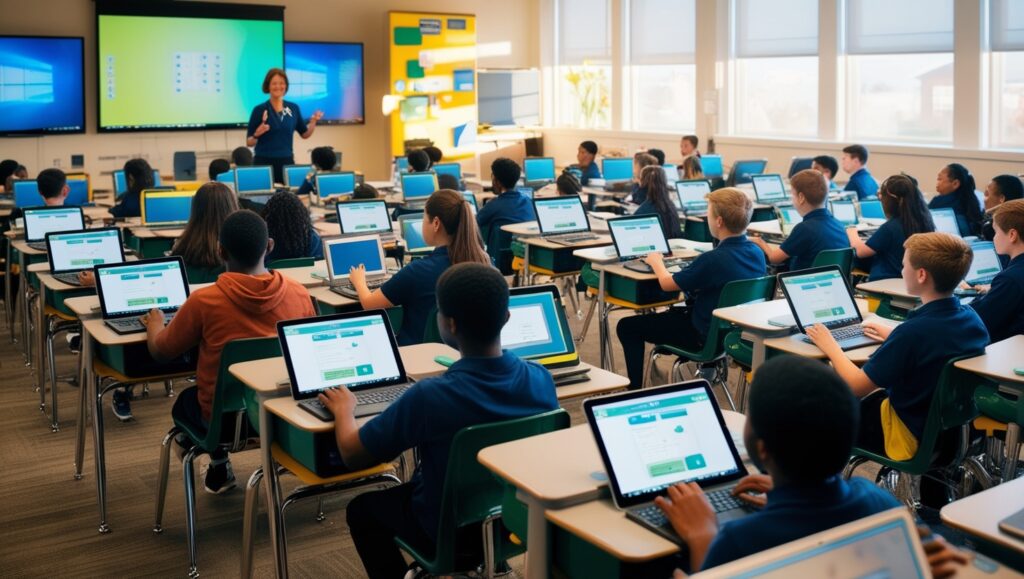Digital classrooms represent the next evolution in education, leveraging technology to create interactive, personalized, and accessible learning environments. With the rapid advancement of digital tools and the growing demand for flexible, remote learning, technology is transforming how knowledge is delivered, absorbed, and assessed. This shift offers unprecedented opportunities for educators and students, but it also brings challenges that require thoughtful implementation. In this article, we explore the benefits, challenges, and future of digital classrooms as they shape the future of education.
What Are Digital Classrooms?

Digital classrooms are learning environments where technology enhances teaching and learning. These classrooms use tools like interactive whiteboards, learning management systems (LMS), and virtual collaboration platforms to:
- Facilitate remote and hybrid learning.
- Provide multimedia resources, such as videos, simulations, and e-books.
- Enable real-time communication between teachers and students, regardless of location.
- Use data-driven insights to personalize education.
Benefits of Digital Classrooms
Digital classrooms offer numerous advantages for students, educators, and institutions:
1. Accessibility and Flexibility
- Anywhere, Anytime Learning: Students can access educational materials from any location, enabling flexible schedules.
- Global Reach: Remote learning connects students with educators worldwide, expanding access to quality education.
2. Personalized Learning
- Adaptive learning platforms use AI to tailor lessons to individual student needs, addressing gaps and accelerating progress.
- Self-paced modules allow students to revisit materials and learn at their own speed.
3. Enhanced Engagement
- Interactive tools, gamification, and multimedia resources make lessons more engaging and relatable.
- Virtual and augmented reality (VR/AR) provide immersive learning experiences, such as virtual science labs or historical site tours.
4. Collaboration and Communication
- Digital platforms facilitate collaboration through group projects, discussion forums, and real-time chats.
- Teachers can provide immediate feedback on assignments, ensuring timely guidance.
5. Cost Efficiency
- Digital classrooms reduce the need for physical resources like textbooks, printing, and infrastructure, lowering costs for schools and students.
Key Technologies in Digital Classrooms
The foundation of digital classrooms lies in innovative technologies that enhance teaching and learning:
1. Learning Management Systems (LMS)
- Platforms like Google Classroom, Canvas, and Blackboard streamline course management, communication, and resource sharing.
2. Virtual and Augmented Reality
- Tools like Oculus Rift and Google Expeditions provide immersive learning experiences that bring abstract concepts to life.
3. Artificial Intelligence (AI)
- AI-powered tools, such as chatbots and personalized tutors, offer tailored support and real-time problem-solving assistance.
4. Gamification
- Educational games and interactive quizzes make learning enjoyable while reinforcing concepts.
5. Cloud Computing
- Cloud-based solutions allow seamless storage and sharing of educational resources, enabling collaboration and remote access.
Challenges of Digital Classrooms
Despite their potential, digital classrooms face several challenges that need to be addressed for successful implementation:
1. Digital Divide
- Limited access to technology and reliable internet connections creates inequities among students, particularly in underserved communities.
2. Teacher Training
- Educators need ongoing training to effectively integrate technology into their teaching methods.
3. Screen Fatigue
- Prolonged exposure to screens can lead to decreased attention spans and physical discomfort among students.
4. Cybersecurity and Privacy Concerns
- Ensuring the security of student data and protecting privacy is critical in digital learning environments.
5. Overreliance on Technology
- Overdependence on digital tools may reduce interpersonal interactions and traditional problem-solving skills.
Strategies for Successful Digital Classrooms
To maximize the benefits of digital classrooms, schools and institutions should consider the following strategies:
1. Invest in Infrastructure
- Provide reliable internet access, devices, and IT support to ensure all students can participate effectively.
2. Promote Digital Literacy
- Teach students and educators to use technology responsibly and effectively, focusing on skills like online research, data privacy, and ethical usage.
3. Blend Digital and Traditional Methods
- Combine face-to-face instruction with digital tools to balance interpersonal engagement and technological benefits.
4. Ensure Accessibility
- Use assistive technologies, such as screen readers and speech-to-text tools, to support diverse learners, including those with disabilities.
5. Foster Collaboration
- Encourage group work and peer-to-peer learning through virtual platforms to build teamwork and communication skills.
The Future of Digital Classrooms
The future of digital classrooms is dynamic, with emerging trends and technologies poised to redefine education further:
1. Artificial Intelligence and Machine Learning
- AI-driven tools will provide deeper insights into student performance, enabling even more personalized learning experiences.
2. Immersive Technologies
- AR and VR will become more affordable and widespread, offering students hands-on experiences in fields like medicine, engineering, and the arts.
3. Global Learning Communities
- Digital classrooms will connect students and educators from diverse cultural backgrounds, fostering cross-cultural understanding and collaboration.
4. Hybrid Models
- The integration of in-person and virtual learning will remain a key feature, providing flexibility and adaptability.
5. Data-Driven Decision Making
- Advanced analytics will help educators identify trends, predict learning outcomes, and improve instructional strategies.
Conclusion: Shaping the Future of Education
Digital classrooms are revolutionizing education, breaking down barriers to access and enabling innovative approaches to teaching and learning. By embracing technology, educators can create engaging, personalized, and inclusive environments that prepare students for a rapidly changing world. While challenges remain, thoughtful implementation and investment in infrastructure and training can ensure that digital classrooms fulfill their potential to transform education for the better. As we look to the future, the fusion of technology and education promises a brighter, more connected, and more equitable world of learning.